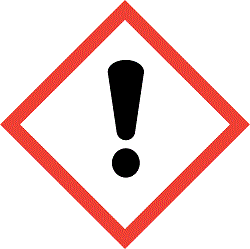Hazardous to the ozone layer
Non-additivity approach
The additivity approach is not applicable for calculation of classification hazardous to the ozone layer.
If a single ingredient classified as hazardous to the ozone layer is present in the mixture above the generic or specific concentration limit the mixture must be classified for that hazard. Other hand, if the mixture contains two or more ingredients each below the generic or specific concentration limit, even if the sum of their concentrations is above generic concentration limit, the mixture will not be classified.
The mixture is classified as a hazardous to the ozone layer (Category 1) if at least one ingredient in a mixture is classified as hazardous to the ozone layer (Category 1) in accordance with Table 5.1 of Annex I to CLP.
| Component classified as |
Generic concentration limits triggering classification of a mixture |
| Ozone 1 |
C ≥ 0.1 % |
To select pictogram, signal word, hazard and precautionary statements please refer to Annex I, part 3, table 5.2 of Regulation (EC) no 1272/2008 (CLP).
There is a mixture.
| Ingredient |
Conc. % (w/w) |
Classification |
| Substance A |
2.0 |
Ozone 1: H420 |
| Substance B |
0.1 |
Ozone 1: H420 |
| Substance C |
0.09 |
Ozone 1: H420 |
| Inert substance |
97.81 |
− |
Cut-off limits
| − |
There is no generic cut-off limit for substances classified as hazardous to the Ozone layer (CLP, Annex I, Table 1.1), therefore, any concentration of an ingredient with such classification is taken into account. |
Specific and Generic concentration limits
| − |
Because no specific concentration limits are applied for any ingredient, concentrations of mixture's ingredients must be compared to generic concentration limits. |
Calculation of 'Ozone 1'
| − |
Concentration of substance A is above the generic concentration limit 0.1 %. This leads to classification Ozone 1 . |
| − |
Concentration of substance B equals to the generic concentration limit 0.1 %. This leads to classification Ozone 1 . |
| − |
Concentration of substance C is below the generic concentration limit 0.1 %. This does not lead to classification 'Ozone 1'. |
Selection of hazard category
| − |
The mixture is classified as 'Ozone 1'. |
Selection of hazard statements
| − |
H420 corresponds to 'Ozone 1'. |
Selection of pictogram and signal word
| − |
Pictogram GHS07 and signal word 'Warning' correspond to 'Ozone 1'. |
Selection of precautionary statements
| − |
For H420 following precautionary statements are applied: P502. |
Classification and labelling of the mixture
| Classification: |
Ozone 1 |
| Hazard statements: |
H420 |
| Pictogram: |
 |
|
GHS07 |
| Signal word: |
Warning |
| Precautionary statements: |
P502 |
There is a mixture.
| Ingredient |
Conc. % (w/w) |
Classification |
| Substance A |
0.09 |
Ozone 1: H420 |
| Substance B |
0.09 |
Ozone 1: H420 |
| Substance C |
0.09 |
Ozone 1: H420 |
| Inert substance |
99.73 |
− |
Cut-off limits
| − |
There is no generic cut-off limit for substances classified as hazardous to the Ozone layer (CLP, Annex I, Table 1.1), therefore, any concentration of an ingredient with such classification is taken into account. |
Specific and Generic concentration limits
| − |
Because no specific concentration limits are applied for any ingredient, concentrations of mixture's ingredients must be compared to generic concentration limits. |
Calculation of 'Ozone 1'
| − |
Concentrations of substances A, B and C are below the generic concentration limit 0.1 %. This does not lead to classification 'Ozone 1'. |
Classification of the mixture
The mixture is not classified.
